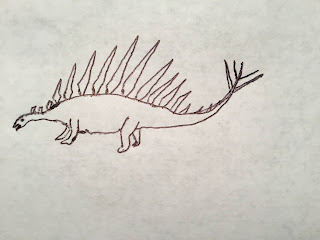Appearance of Cretaceous Stegosaurs
A hypothetical restoration of Wuerhosaurus homheni. Mongolostegus may be synonymous with the geologically youngest known stegosaur, W. ordosensis. Based on ilia less outwardly flared those those of W. homheni, W. ordosensis/Mongolostegus may have been less nodosaur-like but this is not certain.
Stegosaurs lasted from the mid Jurassic to the mid Cretaceous, but their fossil record is heavily biased toward the first half of their range. Whereas Huayangosaurus, Dacentrurus, Kentrosaurus, Stegosaurus and other Jurassic taxa are known from fairly complete remains, Cretaceous taxa are represented only by fragments. Paranthodon, Amargastegos and Mongolostegus are too poorly known to be restored.
Sparse as the Cretaceous record is, it can provide some insight into evolutionary changes in the last stegosaurs. For example, the ilia of Wuerhosaurus flare outward anteriorly. Diverging more from the midline than in Jurassic taxa, the ilia indicate a wider body, more like an ankylosaur than a stegosaur. Likewise, short forelimbs point to a lower profile than in earlier species. The sketch above reflects this apparent change. Most restorations of Wuerhosaurus seem inaccurate as they mimic Stegosaurus or other Jurassic forms.
A lower profile may have led to a change in osteoderms. Plates and spines combined with a high back to make the animal appear as tall and formidable as possible, warding off rivals or predators. It is possible that Wuerhosaurus compensated for its lower profile with exceptionally tall plates, as depicted above. As Maidment noted, it is a fallacy to conclude Wuerhosaurus plates were shrunken; shortness was due to breakage and is illusory. On the contrary, the plates may have been high and narrow (hence susceptible to breakage as fossils).
Considering that plates and spines conferred little if any real protection, it may seen odd that such a defense persisted well into the Cretaceous. The last stegosaurs evolved a more ankylosaurian profile; why didn't they also evolve a more ankylosaurian defense? Plates and spines, however, were probably as effective as regular armor if not more so. The "scary" appearance of long spines or plates, rising high above the back, may have been intimidating enough to prevent most attacks in the first place. That would've been more advantageous than withstanding attack. It wouldn't be surprising, therefore, if the last stegosaurs, including Mongolostegus, adhered to this basic survival strategy. Perhaps they even enhanced it, as depicted above. No doubt, more complete specimens of EK stegosaurs would clarify matters.

